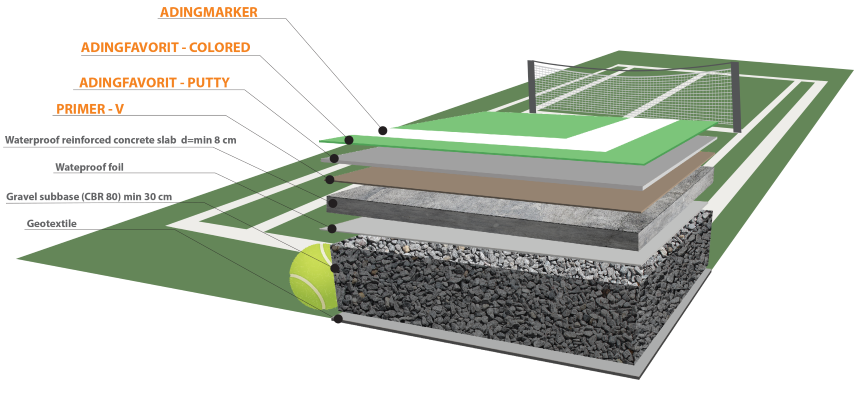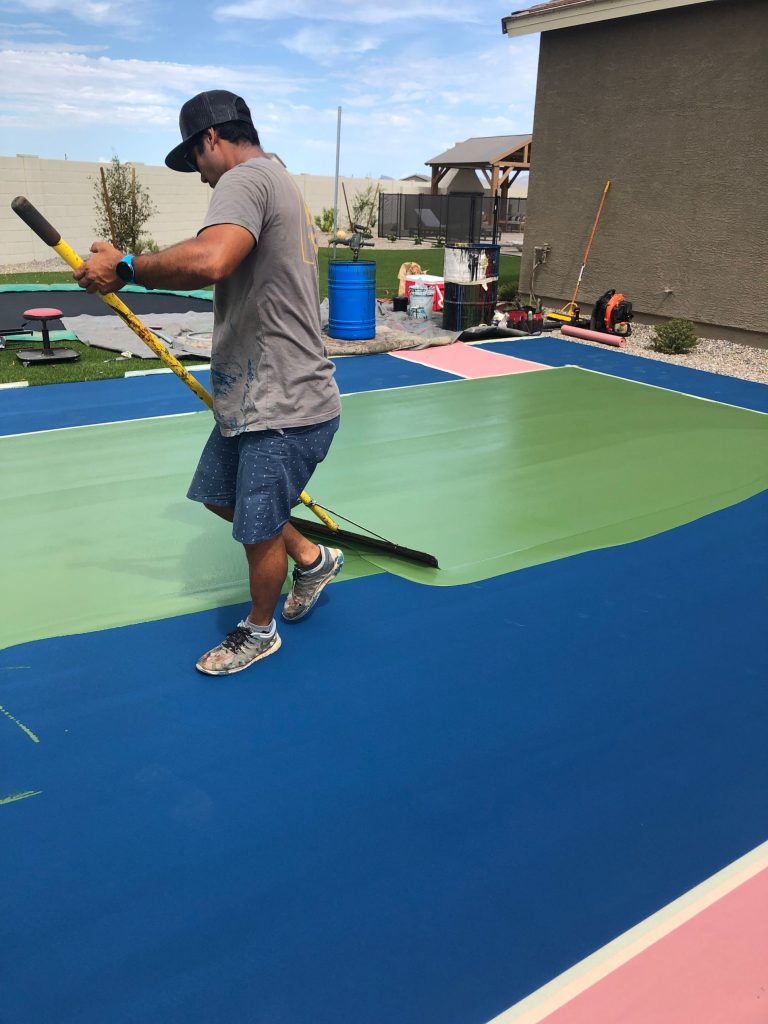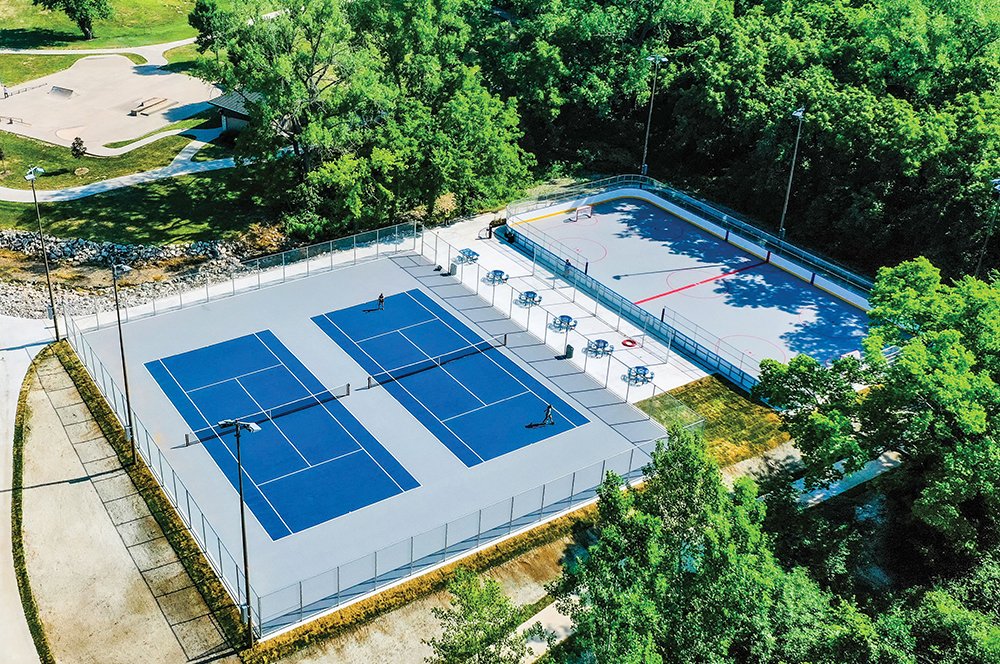As Pickleball has taken off in popularity, dedicated pickleball courts have popped up at public parks, recreation centers, schools, and private clubs. These courts come in different textures and coatings, which can significantly impact the playability and safety of the game. This article will examine how the texture of pickleball court surfaces affects grip, ball bounce, joint impact, and risk of injury.
- The Need for Some Texture on Pickleball Courts
- Common Textures Used on Pickleball Courts
- The Effect of Court Texture on Ball Bounce and Pace
- The Effect of Surface Texture on Traction and Grip
- Cushioning Ability of Textured Surfaces
- Effect of Surface Texture on Safety and Injury Risk
- Recommendations for Optimal Court Surfaces
- In Closing
The Need for Some Texture on Pickleball Courts
Pickleball is played with a hard plastic ball that has holes in it. This gives the ball an unpredictable bounce. On completely smooth, untextured court surfaces like unfinished concrete or pavement, the ball can skid and slide unpredictably. This makes it difficult to play proper strokes and shots since the ball reacts inconsistently coming off the paddle.
As the USA Pickleball Association (USAPA) states in their pickleball overview:
“For outdoor pickleball courts, a rough finish is recommended over smooth concrete to help provide the appropriate traction and consistent ball bounce.”
Adding some texture helps give the pickleball more grip on the court so it bounces and reacts more consistently. This allows players to accurately judge bounces and aim shots. It also enables effective dinks, drop shots, and ball spin.
Without any grip from texture, the game becomes extremely challenging. Shots ricochet sideways off the paddle and dinks can skid right off the court. Plus, the ball is slippery and hard to control coming off the paddle on a smooth surface.
- How Much Tape for Pickleball Court?
- Where Do You Play Pickleball in RI?
- The Complete Guide to Building a Pickleball Court on Grass
Common Textures Used on Pickleball Courts
There are a few different textures commonly used on dedicated pickleball courts and converted tennis courts to add grip:
- Acrylic latex color coatings: These multicolored coatings provide a light texture and smooth consistency ideal for pickleball. They come in various grit sizes to control the level of texture. The microtexture improves traction while maintaining a consistent ball bounce.
- Sand or silica additives: Finely ground silica sand mixed into paint or other coatings is a common way to add light texture. The sand grains provide grip while maintaining a relatively smooth surface.
- Adhesive grit tapes: These adhesive-backed gritty tapes can be applied to existing tennis or basketball courts to impart texture ideal for pickleball. They come in smooth or aggressive textures.
- Acrylic surfacing: Textured, perforated acrylic sheets can be installed over existing slabs to create ideal outdoor pickleball surfaces. The holes allow water drainage while the texturing provides ball grip.
- Asphalt: New asphalt can be mixed with certain aggregates to create good traction for pickleball once the oils wear off. The texture is on the rougher end.
- Sport court tiles: Interlocking outdoor tiles made for pickleball have textured or dimpled surfaces to emulate asphalt or acrylic court coatings while allowing modular installation.
The Effect of Court Texture on Ball Bounce and Pace
The texture of the court surface has a direct impact on the bounce and pace of the ball during play. A rougher, more textured surface will grab the ball more on the bounce, resulting in a lower and slower bounce.
A very smooth surface like unfinished concrete or pavement provides a fast pace and high bounce since the ball slides and skids more. This can make ball control challenging.
According to the USA Pickleball Association, the ideal bounce for proper pickleball play is in the range of 3 to 5 inches on the baseline. This moderately slow, controlled bounce allows for best playability.
The ideal court texture provides enough grip to facilitate ball control and spin without overly reducing pace and bounce. As pickleball pro Simone Jardim notes about court textures:
“You want the ball to bounce true and consistent. Not too high, not too low. The texture of the surface plays a big role here.”
A rougher or more irregular texture can lead to inconsistent bounces, making it hard to control shots. Smooth coatings with light grit or sand tend to provide an optimal mid-range texture for consistent bounces.
- Does LA Fitness Have Pickleball Courts? We Called 50+ Locations To Find Out
- Where Are Pickleball Courts at Jones Beach?
- How To Measure Pickleball Court Dimensions in Feet?
The Effect of Surface Texture on Traction and Grip

Traction is crucial in a fast-paced sport like pickleball that involves quick changes of direction. The texture of the court coating largely determines the level of traction it provides.
Smooth, untextured surfaces like indoor basketball courts can become extremely slippery for pickleball play, leading to falls and injuries. Too much grip from an overly textured surface can also hinder quick lateral and pivoting movements.
According to sports court construction company Copeland Coating, the ideal texture for pickleball shoes is a fine grit texture:
“A fine grit texture provides great traction and allows for sliding while helping prevent falls and injuries.”
The right balance of texture enables good traction for starting, stopping, and changing direction without overly grabbing the shoe soles. This allows dynamic lateral movements needed in pickleball.
Cushioning Ability of Textured Surfaces
In addition to ball bounce and traction, the texture or coating system used on a pickleball court provides valuable cushioning. This cushioning helps absorb shock and reduce joint stress compared to harder surfaces like concrete.

“Coatings on the court provide cushioning to enhance playability and absorb impact on joints, a great benefit to Pickleball players.”
The microscopic texture from sand additives or acrylic coatings provides a layer of cushioning. This cushioning becomes increasingly important as a large percentage of pickleball players are over age 55.
- How to Petition Your HOA to Build a Pickleball Court? (6 Simple Steps)
- Cost Of Installing A Pickleball Court in 2024
- Do They Have Pickleball in Aruba?
Effect of Surface Texture on Safety and Injury Risk
The texture and friction characteristics of the court play a key role in player safety and injury risk. A surface with too much or too little texture can increase the potential for injuries.
Insufficient texture leads to a slippery surface with poor traction. Players are at higher risk of falls and slides that result in injuries like twisted ankles or knees. Wet smooth surfaces become extremely hazardous.
Excessive texture from aggressive coatings or aggregates can “grab” feet and hinder quick changes in movement. This dynamic traction puts greater force on joints and tendons and may increase potential strains.
The ideal pickleball texture allows slidng without grabbing the shoe excessively. This facilitates safer play by enabling quick starts, stops, pivots and lateral movements. Proper traction also prevents slips and falls leading to acute injuries.
Cushioning from texture likewise aids safety by reducing impact on joints like ankles, knees, and hips. This results in fewer overuse issues that often arise on harder surfaces.
Recommendations for Optimal Court Surfaces

Based on factors of playability, safety, and longevity, here are recommendations on optimal pickleball court textures:
- Outdoor courts – Look for acrylic latex surfaces or coatings with light sand additives. These provide grip while maintaining a consistent bounce. Sport court tiles are another good outdoor option.
- Indoor courts – Go for a low-texture surface for indoor play. Smooth sport court tiles work well. Adhesive grit tapes in smaller grit sizes can also impart ideal texture.
- Converted tennis courts – Add pickleball lines and apply adhesive grit tape or acrylic coatings to introduce a light texture suitable for pickleball on existing tennis surfaces.
- New construction – Consider an acrylic or asphalt surface with proper aggregates to achieve good traction and playability. Allow 1-2 years for asphalt to age appropriately.
- Multipurpose courts – When building courts for tennis, basketball, and pickleball, go for a medium grit texture. This accommodates all 3 sports. Tapes and coatings can help refine texture for pickleball.
No matter what coating or texture you choose, be sure it provides the appropriate balance of traction, cushioning, and bounce for optimal and safe pickleball play. Consult sports flooring contractors and consider having potential surfaces tested on site with paint samples.
- How to Petition Your HOA to Build a Pickleball Court? (6 Simple Steps)
- What Are Affordable Ways To Build a Backyard Pickleball Court?
- The Complete Guide to Building a Pickleball Court on Grass
In Closing
The texture of the court coating has a significant influence on playability, joint impact, and safety in pickleball. The right surface texture improves control by enabling spin and consistent bounces while providing sufficient traction. Cushioning in textured coatings also enhances safety and fun. With pickleball’s meteoric rise in popularity, proper court construction is key so people can enjoy the sport safely and comfortably for years to come.
- What Are Affordable Ways To Build a Backyard Pickleball Court?
- How Much Does a Pickleball Court Cost? A Detailed Look at Traditional, Synthetic, and VersaCourt Prices
- Does Disney World Have Pickleball Courts
- Pickleball Court vs Badminton Court (Detailed Comparison in Courts)
- Cost Of Installing A Pickleball Court in 2024
- How Often Should Pickleball Courts Be Re-Coated To Ensure Optimum Performance and Longevity?
- Are You Looking for Best Pickleball Experience in Austin?
- Can You Play Pickleball on Clay Courts?
- Where Can I Play Pickleball in NYC?
- How Much Paint Do I Need for a Pickleball Court?
- 10 Modified Pickleball Practice Drills From Coaches To Ease Back Into Play Gently After A Shoulder Injury
- Will Pickleball Overtake Tennis?
- How to Make a Pickleball Paddle at Home? Easy Steps
- What to Wear To Play Pickleball? (Tips By Pickleball Experts)
- 13 Best Men’s Tennis Shoes For Pickleball (2023)
- Struggling to Understand Pickleball Levels? This Simple Pickleball Levels Chart Will Instantly Show You Where You Rank
- Pickleball: Professional Sport or Amateur Pastime?
- What are Legacy Singles and Doubles in Pickleball? (Beginners Guide)
- Where Can I Play Pickleball in Edmonton? Best Places Pickleball Edmonton
- How Pickleball Is Taking Over America?
- How Are Pickleball Ratings Determined?
- SF Pickleball Courts Face Backlash
